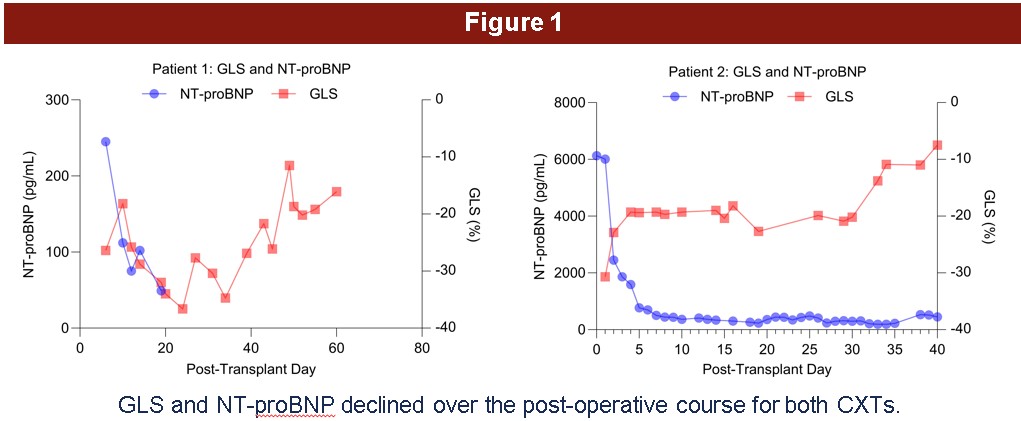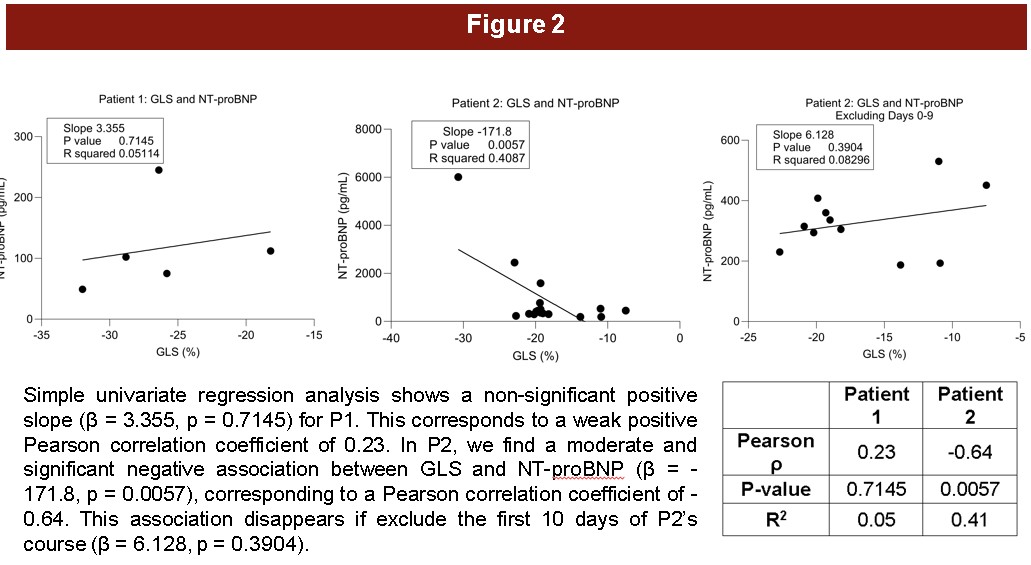Correlation of left ventricular global longitudinal strain with NT-proBNP in the first and second genetically modified porcine to human xeno heart transplant
Javier Galindo2, Muhammad M Mohiuddin2, Andy A Tully2, Avneesh K Singh2, Sarah Leventhal2, Marco Oldsman2, Sarah Cipriano2, Susie Hong-Zohlman2, Timm Dickfeld2, Mohammed Asadi2, Brian Barr2, Albert Hicks2, Anuj Gupta2, Erika Feller1, Dave Ayares3, Bartley Griffith2, Manjula Ananthram2.
1Cardiology, MedStar, Baltimore, MD, United States; 2Surgery, University of Maryland, Baltimore, MD, United States; 3Revivicor, Blacksburg, VA, United States
Background: Xenotransplantation is emerging as a potential therapeutic modality for the treatment of end organ failure, however translation to the clinic will require intensive surveillance of rejection and graft dysfunction. Global longitudinal strain (GLS)1-3 has been shown to be a sensitive marker of rejection and is predictive of major adverse cardiac events & all-cause mortality in cardiac allograft recipients in the heart allotransplantation literature. Our institution performed two genetically modifed porcine to human cardiac xenotransplants (CXT)6,7. Patient 1 (P1) & Patient 2 (P2) were declined for allotransplantation & mechanical circulatory support at multiple centers. We observed progressive declines in GLS in both CXTs. It was hypothesized that GLS would correlate with biochemical markers of xenograft dysfunction (XGD), specifically serum NT-proBNP values. A retrospective analysis was conducted to investigate this.
Methods: Serial transthoracic echocardiography (TTE) was performed & NT-proBNP measurements were obtained . NT-ProBNP is only available for the first 3 weeks for P1. TTE was analyzed to calculate GLS. Simple univariate linear regression was performed & Pearson correlation coefficient was calculated using GraphPad Prism 10 (Dotmatics, Boston, MA).
Results: GLS declined to about -10% in both patients. In P1, NT-proBNP fell post-operatively from a mildly elevated value of 245 pg/mL. In P2, NT-proBNP fell from a peak of about 6000 pg/mL to 230 pg/mL on day 19 before rising slightly late in the patient’s course. Regression analysis shows a non-significant positive slope (β = 3.355, p = 0.7145) for P1. This corresponds to a weak positive Pearson correlation coefficient of 0.23.In P2, the high starting value of NT-proBNP reflects his pre-transplant condition and results in a moderate and significant negative association between GLS and NT-proBNP (β = -171.8, p = 0.0057). This corresponds to a Pearson correlation coefficient of -0.64. If we exclude the first 10 days of P2’s course, this correlation disappears (β = 6.128, p = 0.3904).
Discussion: As expected from what is known about its use in cardiac allotransplantation, these data demonstrate that GLS is a sensitive predictor of graft dysfunction in cardiac xenotransplantation. Although we observe a negative and statistically significant correlation between GLS and NT-proBNP, this effect is driven by the high pre-operative NT-proBNP values and disappears when excluding days 0 to 9. These results are in line with what is described in the allotransplantation literature, where GLS has been shown to predict all cause mortality in transplant recipients, whereas NT-proBNP is of limited prognostic value. A modest, non-significant correlation between GLS and NT-proBNP was observed in the first two cardiac xenograft recipients. While GLS remains a valuable prognostic tool in assessing xenograft health, NT-proBNP appears to be of limited utility.


[1] Echocardiography
[2] Surveillance
[3] Rejection